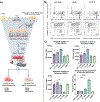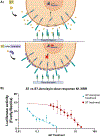Single-Chain Nanobody Inhibition of Notch and Avidity Enhancement Utilizing the β-Pore-Forming Toxin Aerolysin
- PMID: 40079390
- PMCID: PMC12184807
- DOI: 10.1021/acschembio.4c00803
Single-Chain Nanobody Inhibition of Notch and Avidity Enhancement Utilizing the β-Pore-Forming Toxin Aerolysin
Abstract
Notch plays critical roles in developmental processes and disease pathogenesis, which have led to numerous efforts to modulate its function with small molecules and antibodies. Here we present a nanobody inhibitor of Notch signaling derived from a synthetic phage-display library targeting the Notch negative regulatory region (NRR). The nanobody inhibits Notch signaling in a luciferase reporter assay with an IC50 of about 5 μM and in a Notch-dependent hematopoietic progenitor cell differentiation assay, despite a modest 19 μM affinity for the Notch NRR. We addressed the low affinity by fusion to a mutant varient of the β-pore-forming toxin aerolysin, resulting in a significantly improved IC50 for Notch inhibition. The nanobody-aerolysin fusion inhibits proliferation of T-ALL cell lines with efficacy similar to that of other Notch pathway inhibitors. Overall, this study reports the development of a Notch inhibitory antibody and demonstrates a proof-of-concept for a generalizable strategy to increase the efficacy and potency of low-affinity antibody binders.
Conflict of interest statement
Conflict of interest statement
The authors declare no conflicts of interest in this work.
Figures






Update of
-
Single-chain nanobody inhibition of Notch and avidity enhancement utilizing the β-pore forming toxin Aerolysin.bioRxiv [Preprint]. 2024 Oct 25:2024.10.22.617501. doi: 10.1101/2024.10.22.617501. bioRxiv. 2024. Update in: ACS Chem Biol. 2025 Mar 21;20(3):656-669. doi: 10.1021/acschembio.4c00803. PMID: 39484510 Free PMC article. Updated. Preprint.
References
-
- Bray SJ Notch Signalling: A Simple Pathway Becomes Complex. Nat. Rev. Mol. Cell Biol. 2006, 7 (9), 678–689. - PubMed
Publication types
MeSH terms
Substances
Grants and funding
LinkOut - more resources
Full Text Sources

